Samsung SSD 840 Pro (256GB) Review
by Anand Lal Shimpi on September 24, 2012 7:00 AM EST- Posted in
- Storage
- SSDs
- Samsung
- Samsung SSD 840
Random Read/Write Speed
The four corners of SSD performance are as follows: random read, random write, sequential read and sequential write speed. Random accesses are generally small in size, while sequential accesses tend to be larger and thus we have the four Iometer tests we use in all of our reviews.
Our first test writes 4KB in a completely random pattern over an 8GB space of the drive to simulate the sort of random access that you'd see on an OS drive (even this is more stressful than a normal desktop user would see). I perform three concurrent IOs and run the test for 3 minutes. The results reported are in average MB/s over the entire time. We use both standard pseudo randomly generated data for each write as well as fully random data to show you both the maximum and minimum performance offered by SandForce based drives in these tests. The average performance of SF drives will likely be somewhere in between the two values for each drive you see in the graphs. For an understanding of why this matters, read our original SandForce article.
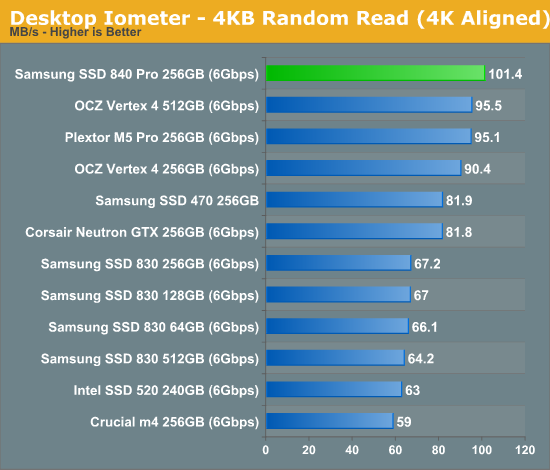
We have a new king, the 840 Pro manages to inch past the fastest Vertex 4 in our random read performance test.
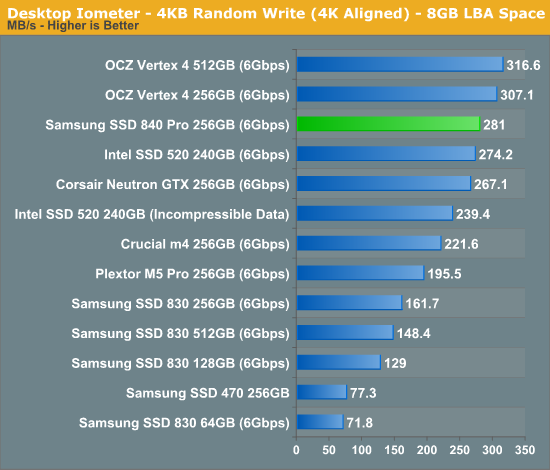
The low queue depth random write performance crown goes back to the Vertex 4, but the 840 Pro is around 75% faster than the old 830. Other than the Vertex 4, there's nothing faster than the 840 Pro here.
Many of you have asked for random write performance at higher queue depths. What I have below is our 4KB random write test performed at a queue depth of 32 instead of 3. While the vast majority of desktop usage models experience queue depths of 0 - 5, higher depths are possible in heavy I/O (and multi-user) workloads:
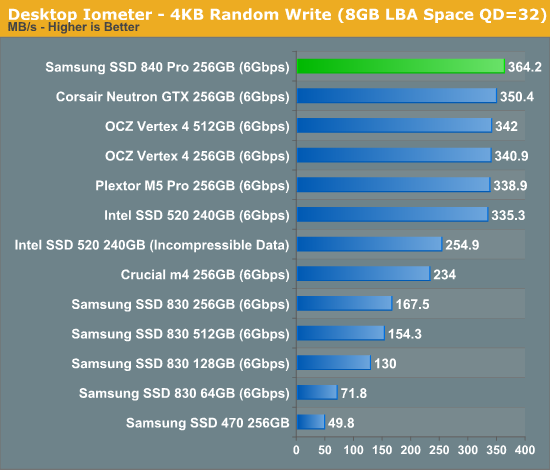
Ramp up queue depth and the 840 Pro manages to even outperform Corsair's new Neutron GTX.
Sequential Read/Write Speed
To measure sequential performance I ran a 1 minute long 128KB sequential test over the entire span of the drive at a queue depth of 1. The results reported are in average MB/s over the entire test length.
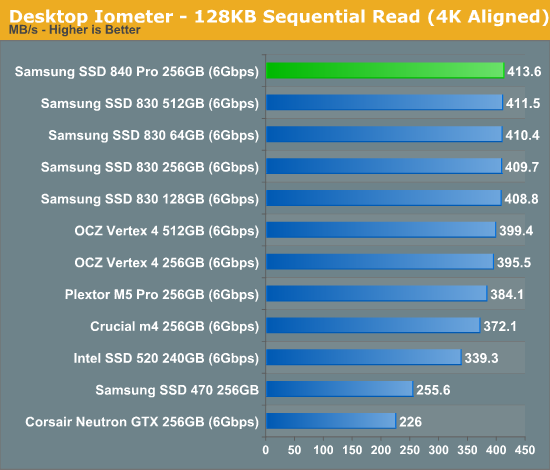
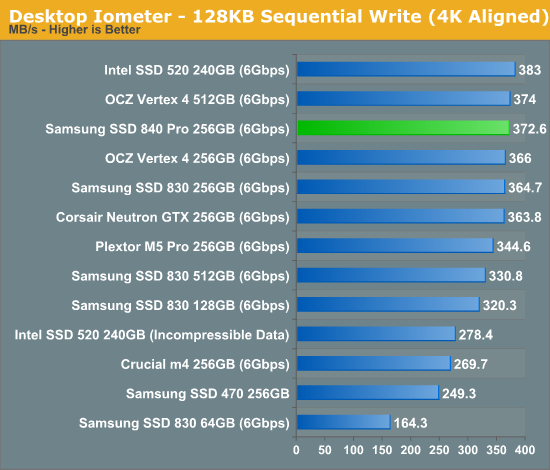
There are no tradeoffs here: excellent random IO performance and class leading low queue depth sequential performance. The 840 Pro is looking like a good all-around performer.
AS-SSD Incompressible Sequential Performance
The AS-SSD sequential benchmark uses incompressible data for all of its transfers. The result is a pretty big reduction in sequential write speed on SandForce based controllers.

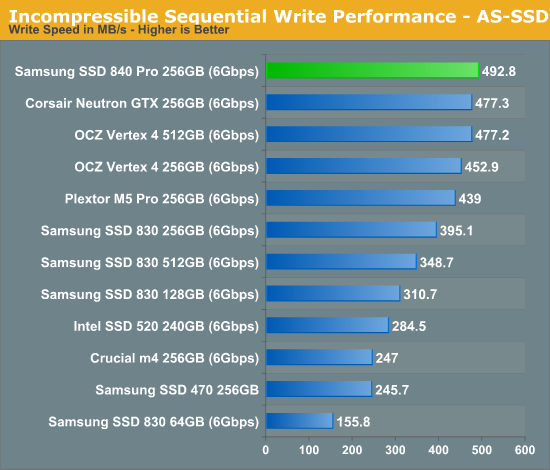
The 840 Pro lands on top once again in these higher queue depth sequential tests. The competition is hot on the heels of the 840 Pro however, we're limited by 6Gbps SATA here so expect continued clustering around 500MB/s going forward.










96 Comments
View All Comments
Old_Fogie_Late_Bloomer - Monday, September 24, 2012 - link
I think I might move my Steam folder to my 64GB 830 (if it hasn't grown too large) and see if Portal II level load times improve. The write times take a hit due to the smaller number of NAND chips, but the read times should be mostly limited by SATA 3 bandwidth. I'll try to pop back in here with a report of any improvements that I see.Old_Fogie_Late_Bloomer - Tuesday, September 25, 2012 - link
Long story short, despite the fact that the 830 64GB beats out the 320 160GB in seven of eight CrystalDiskMark tests (88% in sequential reading, 95% in 512K random read, and so on, except for 4K random write with a queue depth of 32, where the Intel is 70% faster)......I honestly can't say it takes noticeably less time to either load games like Portal, Portal 2, or Quantum Conundrum, or to load levels/saves in those games. Portal 2 might start up a tiny bit faster on the new drive, but I certainly wouldn't swear to it.
repoman27 - Monday, September 24, 2012 - link
The article mentions that this drive uses the new Toggle 2.0 interface which operates at 400 Mbps, however individual packages are clearly capable of more than that if 8 packages can provide sequential speeds greater than 400 MB/s.My understanding is that both ONFI 3.0 and Toggle 2.0 support data rates of 400 MT/s. It would seem that the maximum transfer size for ONFI is 8 bits, so they claim 400 MB/s for the interface. Is the 400 Mbps number for Toggle 2.0 a per die figure? Is it not also capable of 8 bits per transfer and thus 400 MB/s as well?
Kristian Vättö - Monday, September 24, 2012 - link
400Mbit/s is the speed of the Toggle-Mode 2.0 interface but the the interface is 8 bits wide, making the maximum throughput 400MB/s per interface. I know it's stupid that they say 400Mbps because it's just confusingMrMilli - Monday, September 24, 2012 - link
"The basic architecture of the controller hasn't changed. Internally there are three ARM9 cores now running at 300MHz."It's not using ARM9 cores any longer. It's now using Cortex R4 cores. I would say that's a big enough change to say that the basic architecture has changed.
Kristian Vättö - Monday, September 24, 2012 - link
You are correct. Samsung's reviewer's guide originally said ARM9 but yesterday's slides said ARM R4, hence the confusion here :-)Jocelyn - Monday, September 24, 2012 - link
Thank You for the review Anand, but is there any chance you and Kristian could start controlling the variables that are not being tested in future SSD reviews? CPU power saving features (EIST/Turbo) being left on in some reviews, while off in others, definitely affects performance.jwcalla - Monday, September 24, 2012 - link
I have yet to see an SSD that gets better than 75% of the SATA theoretical max -- even SATA II drives. Can the interface really have 25% lost to inefficiencies? That seems like a lot of overhead.repoman27 - Monday, September 24, 2012 - link
SATA uses 8b/10b encoding, so 6Gb/s becomes 600MB/s. Then, just like any transfer protocol, there's additional protocol overhead. The AS-SSD sequential read speeds posted by this drive would demonstrate just better than 85% efficiency, which is not too shabby.Oxford Guy - Monday, September 24, 2012 - link
"The first Samsung MLC SSDs were reliable, they just weren't worth the money when you had much better options from companies like Intel."Intel stuck it to X25M G1 owners by refusing to provide a firmware update to support TRIM. If you're going to praise Intel and criticize Samsung so much in the opening of an article, that should have been noted.